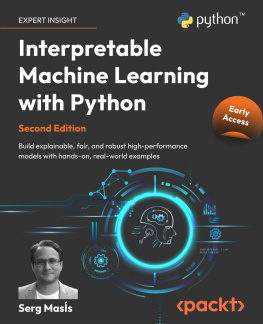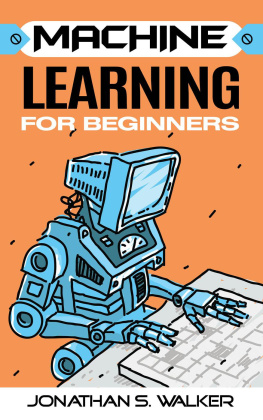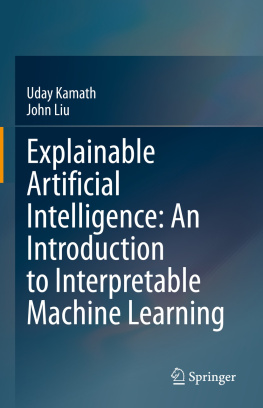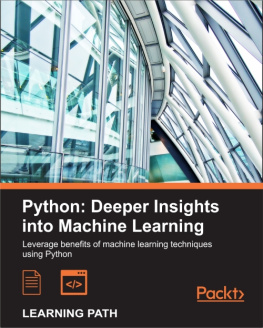Serg Masís - Interpretable Machine Learning with Python
Here you can read online Serg Masís - Interpretable Machine Learning with Python full text of the book (entire story) in english for free. Download pdf and epub, get meaning, cover and reviews about this ebook. year: 2022, publisher: Packt Publishing, genre: Children. Description of the work, (preface) as well as reviews are available. Best literature library LitArk.com created for fans of good reading and offers a wide selection of genres:
Romance novel
Science fiction
Adventure
Detective
Science
History
Home and family
Prose
Art
Politics
Computer
Non-fiction
Religion
Business
Children
Humor
Choose a favorite category and find really read worthwhile books. Enjoy immersion in the world of imagination, feel the emotions of the characters or learn something new for yourself, make an fascinating discovery.
Interpretable Machine Learning with Python: summary, description and annotation
We offer to read an annotation, description, summary or preface (depends on what the author of the book "Interpretable Machine Learning with Python" wrote himself). If you haven't found the necessary information about the book — write in the comments, we will try to find it.
Interpretable Machine Learning with Python — read online for free the complete book (whole text) full work
Below is the text of the book, divided by pages. System saving the place of the last page read, allows you to conveniently read the book "Interpretable Machine Learning with Python" online for free, without having to search again every time where you left off. Put a bookmark, and you can go to the page where you finished reading at any time.
Font size:
Interval:
Bookmark:

Copyright 2022 Packt Publishing
All rights reserved. No part of this book may be reproduced, stored in a retrieval system, or transmitted in any form or by any means, without the prior written permission of the publisher, except in the case of brief quotations embedded in critical articles or reviews.
Every effort has been made in the preparation of this book to ensure the accuracy of the information presented. However, the information contained in this book is sold without warranty, either express or implied. Neither the author, nor Packt Publishing, and its dealers and distributors will be held liable for any damages caused or alleged to be caused directly or indirectly by this book.
Packt Publishing has endeavored to provide trademark information about all of the companies and products mentioned in this book by the appropriate use of capitals. However, Packt Publishing cannot guarantee the accuracy of this information.
Early Access Publication: Interpretable Machine Learning with Python
Early Access Production Reference: B18406
Published by Packt Publishing Ltd.
Livery Place
35 Livery Street
Birmingham
B3 2PB, UK
ISBN: 978-1-80323-542-4
www.packt.comWelcome to Packt Early Access. Were giving you an exclusive preview of this book before it goes on sale. It can take many months to write a book, but our authors have cutting-edge information to share with you today. Early Access gives you an insight into the latest developments by making chapter drafts available. The chapters may be a little rough around the edges right now, but our authors will update them over time.
You can dip in and out ofthis bookorfollow alongfrom start to finish; Early Access is designed to be flexible. We hope you enjoy getting to know more about the process of writing a Packt book.
- Chapter 1: Interpretation, Interpretability and Explainability; and why does it all matter?
- Chapter 2: Key Concepts of Interpretability
- Chapter 3: Interpretation Challenges
- Chapter 4: Global Model-agnostic Interpretation Methods
- Chapter 5: Local Model-agnostic Interpretation Methods
- Chapter 6: Anchor and Counterfactual Explanations
- Chapter 7: Visualizing Convolutional Neural Networks
- Chapter 8: Understanding NLP Transformers
- Chapter 9: Interpretation Methods for Multivariate Forecasting and Sensitivity Analysis
- Chapter 10: Feature Selection and Engineering for Interpretability
- Chapter 11: Bias Mitigation and Causal Inference Methods
- Chapter 12: Feature Selection for Interpretability
- Chapter 13: Adversarial Robustness
- Chapter 14: What's Next for Machine Learning Interpretability?
https://packt.link/EarlyAccessCommunity

We live in a world whose rules and procedures are ever-increasingly governed by data and algorithms.
For instance, there are rules as to who gets approved for credit or released on bail, and which social media posts might get censored. There are also procedures to determine which marketing tactics are most effective and which chest x-ray features might diagnose a positive case of pneumonia.
You expect this because it is nothing new!
But not so long ago, rules and procedures such as these used to be hardcoded into software, textbooks, and paper forms, and humans were the ultimate decision-makers. Often, it was entirely up to human discretion. Decisions depended on human discretion because rules and procedures were rigid and, therefore, not always applicable. There were always exceptions, so a human was needed to make them.
For example, if you would ask for a mortgage, your approval depended on an acceptable and reasonably lengthy credit history. This data, in turn, would produce a credit score using a scoring algorithm. Then, the bank had rules that determined what score was good enough for the mortgage you wanted. Your loan officer could follow it or not.
These days, financial institutions train models on thousands of mortgage outcomes, with dozens of variables. These models can be used to determine the likelihood that you would default on a mortgage with a presumed high accuracy. If there is a loan officer to stamp the approval or denial, it's no longer merely a guideline but an algorithmic decision. How could it be wrong? How could it be right?
Hold on to that thought because, throughout this book, we will be learning the answers to these questions and many more!
To interpret decisions made by a machine learning model is to find meaning in it, but furthermore, you can trace it back to its source and the process that transformed it. This chapter introduces machine learning interpretation and related concepts such as interpretability, explainability, black-box models, and transparency. This chapter provides definitions for these terms to avoid ambiguity and underpins the value of machine learning interpretability. These are the main topics we are going to cover:
- What is machine learning interpretation?
- Understanding the difference between interpretation and explainability
- A business case for interpretability
Let's get started!
To follow the example in this chapter, you will need Python 3, either running in a Jupyter environment or in your favorite integrated development environment (IDE) such as PyCharm, Atom, VSCode, PyDev, or Idle. The example also requires the requests, bs4, pandas, sklearn , matplotlib, and scipy Python libraries. The code for this chapter is located here: https://github.com/PacktPublishing/Interpretable-Machine-Learning-with-Python/tree/master/Chapter01.
To interpret something is to explain the meaning of it. In the context of machine learning, that something is an algorithm. More specifically, that algorithm is a mathematical one that takes input data and produces an output, much like with any formula.
Let's examine the most basic of models, simple linear regression, illustrated in the following formula:

Once fitted to the data, the meaning of this model is that predictions are a weighted sum of the x features with the coefficients. In this case, there's only one xfeature or predictor variable, and the y variable is typically called the response or target variable. A simple linear regression formula single-handedly explains the transformation, which is performed on the input data x1 to produce the output . The following example can illustrate this concept in further detail.
If you go to this web page maintained by the University of California, http://wiki.stat.ucla.edu/socr/index.php/SOCR_Data_Dinov_020108_HeightsWeights, you can find a link to download a dataset of 25,000 synthetic records of weights and heights of 18-year-olds. We won't use the entire dataset but only the sample table on the web page itself with 200 records. We scrape the table from the web page and fit a linear regression model to the data. The model uses the height to predict the weight.
Font size:
Interval:
Bookmark:
Similar books «Interpretable Machine Learning with Python»
Look at similar books to Interpretable Machine Learning with Python. We have selected literature similar in name and meaning in the hope of providing readers with more options to find new, interesting, not yet read works.
Discussion, reviews of the book Interpretable Machine Learning with Python and just readers' own opinions. Leave your comments, write what you think about the work, its meaning or the main characters. Specify what exactly you liked and what you didn't like, and why you think so.







